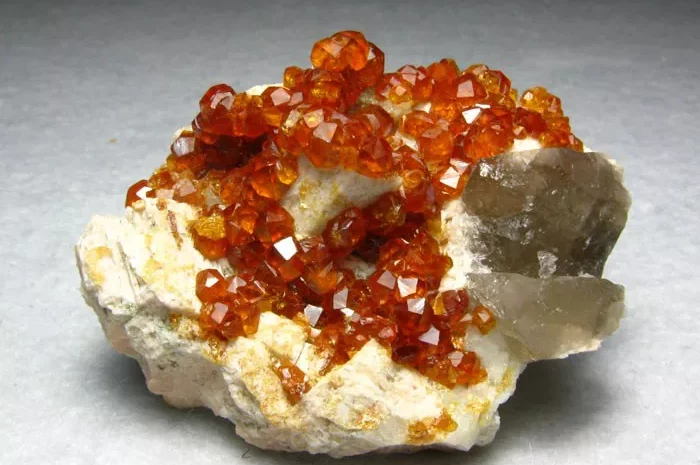Garnets are a fascinating group of gemstones, known for their vibrant colors and historical significance. Among the various types of garnets, Rhodolite and Umbalite stand out due to their unique properties and stunning appearances. This article will delve into the differences between Rhodolite and Umbalite garnets, exploring their origins, chemical compositions, physical characteristics, and market values.
Introduction to Garnets
Garnets are silicate minerals that have been used as gemstones and abrasives for thousands of years. They come in a variety of colors, from deep reds to greens, oranges, and even blues. The garnet family is divided into several species, each with its distinct chemical composition. Rhodolite and Umbalite are varieties of the pyrope and almandine species, respectively.
What is Rhodolite Garnet?
Chemical Composition and Structure
Rhodolite is a mix of pyrope and almandine garnets, typically containing 70% pyrope and 30% almandine. Its chemical formula can be represented as (Mg, Fe)₃Al₂(SiO₄)₃. The presence of magnesium and iron in Rhodolite gives it its characteristic raspberry-red to purplish-red color.
Physical Properties
Rhodolite garnets are known for their excellent clarity and brilliance. They have a Mohs hardness of 7 to 7.5, making them durable enough for various types of jewelry. Rhodolite exhibits a refractive index of 1.740 to 1.760 and a specific gravity of 3.84. These properties contribute to its vibrant sparkle and fire.
Color and Appearance
The most prized Rhodolite garnets are those with a pure, intense raspberry-red color, free from brown or orange overtones. The gemstone’s color can range from light purplish-red to deep, almost amethyst-like hues. Its transparency and lack of inclusions make it a favorite among gem collectors and jewelers.
What is Umbalite Garnet?
Chemical Composition and Structure
Umbalite is a variety of garnet that belongs to the pyrope-spessartine-almandine series. Its chemical composition can be represented as (Mg, Fe, Mn)₃Al₂(SiO₄)₃. The presence of manganese, along with magnesium and iron, gives Umbalite its distinct pink to reddish-pink color.
Physical Properties
Like Rhodolite, Umbalite garnets also exhibit excellent clarity and brilliance. They share a similar Mohs hardness of 7 to 7.5, making them suitable for everyday wear in jewelry. Umbalite garnets have a refractive index of 1.740 to 1.760 and a specific gravity of around 3.85, which is very close to that of Rhodolite.
Color and Appearance
Umbalite garnets are known for their unique pink to reddish-pink hues. The most sought-after Umbalites display a vibrant, saturated pink color without any brownish or orangish tones. These garnets are often found to be eye-clean, meaning they lack visible inclusions, which enhances their appeal and value.
Key Differences Between Rhodolite and Umbalite Garnets
Color
One of the most significant differences between Rhodolite and Umbalite garnets is their color. Rhodolite garnets are typically raspberry-red to purplish-red, while Umbalite garnets exhibit pink to reddish-pink hues. This color variation is primarily due to the differences in their chemical compositions.
Chemical Composition
Rhodolite is a mixture of pyrope and almandine garnets, with a higher concentration of pyrope. In contrast, Umbalite is a mix of pyrope, spessartine, and almandine, with manganese contributing to its unique pink coloration.
Origin and Discovery
Rhodolite garnets are commonly found in East Africa, particularly in Tanzania and Mozambique, as well as in India and Sri Lanka. Umbalite garnets, on the other hand, are specifically associated with the Umba River Valley region in Tanzania, which is how they got their name. The unique geological conditions in this region give Umbalite its distinct properties.
See Also: Hessonite VS Rhodolite Garnet
Market Value and Pricing
Rhodolite Garnet
Rhodolite garnets are highly valued for their rich color, brilliance, and clarity. High-quality Rhodolite garnets can command prices ranging from $100 to $500 per carat, depending on their size, color saturation, and overall quality. Larger, flawless specimens with intense color can fetch even higher prices.
Umbalite Garnet
Umbalite garnets, while also valued for their beauty and clarity, are generally less expensive than Rhodolite garnets. Prices for high-quality Umbalite garnets typically range from $50 to $200 per carat. However, exceptional specimens with vivid pink coloration and excellent clarity can approach or exceed the prices of Rhodolite garnets.
Uses in Jewelry
Both Rhodolite and Umbalite garnets are popular choices for various types of jewelry, including rings, earrings, pendants, and bracelets. Their durability and vibrant colors make them ideal for everyday wear. Rhodolite garnets are often used in high-end jewelry pieces due to their rich, saturated colors, while Umbalite garnets are favored for their unique and eye-catching pink hues.
Care and Maintenance
Rhodolite Garnet
Rhodolite garnets require minimal maintenance due to their hardness and durability. However, to keep them looking their best, it’s essential to clean them regularly with mild soapy water and a soft brush. Avoid exposing Rhodolite garnets to harsh chemicals or extreme temperatures, as these can damage the stone or affect its color.
Umbalite Garnet
Umbalite garnets also benefit from regular cleaning with mild soapy water and a soft brush. Like Rhodolite, they should be kept away from harsh chemicals and extreme temperatures. Proper care will ensure that Umbalite garnets maintain their vibrant color and clarity for many years.
Conclusion
Rhodolite and Umbalite garnets, while both belonging to the garnet family, exhibit distinct differences in color, chemical composition, and market value. Rhodolite garnets are renowned for their raspberry-red to purplish-red hues, while Umbalite garnets are prized for their unique pink to reddish-pink coloration. Understanding these differences can help gem enthusiasts and jewelry buyers make informed decisions when selecting these beautiful gemstones. Both Rhodolite and Umbalite garnets offer stunning options for various types of jewelry, each with its unique charm and appeal.


